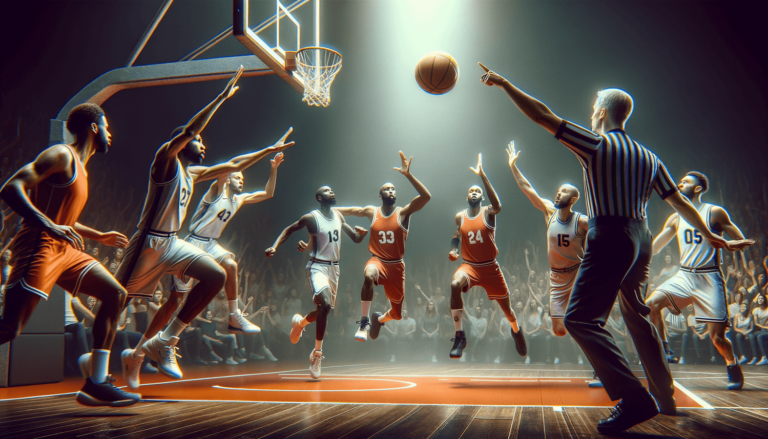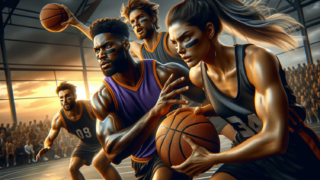
Personal Fouls in Basketball: Rules and Consequences
Written by: Basketball Universe
Last updated:

Welcome to the fascinating world of personal fouls in basketball! 🏀 Rules and consequences surrounding these fouls are vital not only to maintain fair play, but also to safeguard the integrity of this beloved sport. So put on your referee whistle, fasten your high-tops, and get ready to embark on a journey filled with whistles, collisions, and of course, free throws. Whether you are a seasoned aficionado, player, coach, or a hoops newbie, this blog post will provide you with valuable insights on the ins and outs of personal fouls in basketball. Say goodbye to confusion and hello to a slam dunk under⛹️♂️standing of this crucial aspect of the game!
Personal Fouls in Basketball: Rules and Consequences
Personal fouls in basketball are penalties given to players for illegal physical contact against an opponent. Rules governing these fouls vary depending on the level and league of play, but common types include blocking, charging, hand-checking, holding, and reaching in. Consequences for a personal foul include awarding free throws to the opposing team or possession of the ball, and repeated fouls can lead to a player’s disqualification from the game.
Understanding the Different Types of Personal Fouls
In order to fully appreciate the world of personal fouls, it is essential to recognize the various types that can occur during a game. Let’s delve deeper into each category and uncover the specifics that make each foul unique.
1. Blocking Fouls
Blocking occurs when a defender impedes the progress of an offensive player by moving into their path without maintaining a legal defensive position. A legal defensive position requires the defender to have both feet firmly planted on the ground, facing the offensive player. A blocking foul is typically called when the defender fails to establish this position and instead moves laterally or turns their body during contact. When a blocking foul is called, the offensive team retains possession of the ball, and if the team is in the bonus, free throws may be awarded.
2. Charging Fouls
Charging is the opposite of blocking and happens when an offensive player moves into a stationary or established defender, causing significant contact. This type of foul is frequently called when the offensive player is driving to the basket and makes excessive physical contact with the defending player. Charging fouls result in a turnover, and the ball is awarded to the opposing team.
3. Hand-Checking Fouls
Hand-checking occurs when a defender uses their hands or arms to impede the progress of an offensive player, usually when they are dribbling the basketball. This type of foul is especially common at higher levels of play, as it represents a concerted effort by the defender to disrupt the flow of the game. Consequences for hand-checking fouls include team fouls, and if a team is in the bonus, free throws may be awarded.
4. Holding Fouls
A holding foul is called when a player uses their hands or arms to grasp, hold, or hook an opponent to prevent them from moving freely on the court. This type of foul can occur both offensively and defensively, and is often called when a player is attempting to set a screen or fight through a screen to stay with their assigned opponent. Holding fouls result in team fouls, and if a team is in the bonus, free throws may be awarded.
5. Reaching-In Fouls
Reaching-in fouls occur when a defender attempts to steal the basketball from an offensive player by reaching across their body or extending their arm into the opponent’s space. This type of foul is often committed by players who are trying to make a quick steal, but end up making excessive contact with the ball handler. The outcome of a reaching-in foul includes team fouls, and if a team is in the bonus, free throws may be awarded.
The Consequences of Personal Fouls
Now that we’ve explored the various types of personal fouls, it’s time to understand the consequences that follow. From free throws to foul trouble, the ramifications of personal fouls can significantly influence the outcome of a basketball game.
1. Free Throws
One of the primary consequences of a personal foul is the potential awarding of free throws to the opposing team. In most basketball rules, when a team reaches a certain number of fouls per half or quarter (commonly known as the “bonus” or “penalty” situation), subsequent non-shooting fouls result in one or more free throw opportunities for the fouled player. Additionally, if a player is fouled while in the act of shooting, they may be awarded free throws regardless of the team’s foul count.
2. Possession of the Ball
Another consequence of a personal foul is the loss or retention of possession of the basketball. In many cases, a foul will result in a turnover, awarding the opposing team possession of the ball. However, certain fouls may allow the offensive team to retain possession or inbound the ball from the sideline. The specific outcome depends on the type of foul committed and the current game situation.
3. Foul Trouble: A Player’s Dilemma
Players must also be cautious about accumulating too many personal fouls during a game, as this can lead to disqualification or limit their effectiveness on the court. Basketball rules dictate that a player who accumulates a certain number of fouls (usually five or six, depending on the level of play) is disqualified from the game. As a result, coaches often face the challenge of balancing their star players’ minutes, ensuring they avoid foul trouble and stay eligible to play during critical moments of the game.
4. Team Strategy and Foul Management
Coaches at all levels of basketball must have a deep understanding of personal foul rules and consequences to properly manage their team strategies. Knowing when to intentionally foul to stop the clock, preserve possession, or force an opponent to shoot free throws can be an essential part of a team’s game plan. Additionally, understanding how to avoid certain fouls as a defender or exploit a defender’s propensity to foul can give a team a crucial edge in competition.
Personal Fouls: Prevention and Discipline
While fouls are an inevitable part of the game, some prevention measures can be taken by players to minimize their occurrence and stay out of foul trouble. Here are some tips to help players avoid personal fouls and maintain discipline on the court.
1. Master the Art of Legal Defense
One of the best ways to avoid personal fouls is by learning and practicing proper defensive techniques. By focusing on maintaining a legal defensive position, players can limit their chances of committing blocking or reaching-in fouls. It is essential to remain aware of body positioning, footwork, and hand placement while defending.
2. Anticipate Opponent’s Moves
Being able to predict an opponent’s next move can help players stay one step ahead and avoid fouling. Analyzing an opponent’s tendencies, strengths, and weaknesses can allow defenders to position themselves better and react faster on the court, leading to fewer fouls and more successful defensive plays.
3. Exercise Self-Control
Exercising self-control on the court is essential in avoiding unnecessary fouls. By keeping emotions in check and remaining focused on the game, players can prevent impulsive actions that may lead to fouls or conflicts with opponents. Maintaining composure and concentrating on basketball fundamentals can significantly reduce the risk of foul trouble.
4. Communication is Key
Effective communication on the court plays a significant role in reducing personal fouls. When teammates communicate about their defensive assignments and positioning, they can avoid situations that commonly lead to fouls, such as illegal screens or contact away from the ball. Continually discussing strategies and providing feedback can create a more cohesive and disciplined team environment.
Understanding and managing personal fouls in basketball is crucial for both players and coaches. By learning the comprehensive guidelines surrounding personal fouls, their consequences, and prevention tactics, everyone involved in the game can contribute to fair play and a greater love for this exhilarating sport.
Foul Recognition: The Referee’s Perspective
Referees play a crucial role in identifying and calling personal fouls during a basketball game. Their ability to accurately interpret the basketball rules and assess the actions of players on the court is essential in maintaining fair play and ensuring the game’s optimal flow. In this section, we will explore the training, skills, and decision-making process of referees when it comes to calling personal fouls.
1. Referee Training and Certification
Similar to athletes, referees undergo rigorous training and certification programs to become qualified for officiating basketball games at various levels. These programs focus on building a deep understanding of the rules, communication skills, and the ability to make decisions quickly under high-pressure situations. Many referees start by officiating at grassroots levels and gradually progress to higher levels, gaining experience and knowledge along the way.
2. The Art of Positioning
One of the keys to calling fouls accurately and consistently is proper positioning on the court. Referees must constantly move and adjust their positioning to get the best possible angles from which to evaluate plays. Effective positioning allows referees to see and interpret the contact between players, resulting in a higher likelihood of making the correct foul call.
3. Judgment and Decision-Making
Referees must use their judgment to assess player contact and determine whether it constitutes a personal foul according to basketball rules. Factors such as the force of the contact, the impact on the player’s movement, and the intent of the contact (incidental or purposeful) all play a part in the referee’s decision-making process. Since every play is different and can involve varying degrees of contact, referees must rely on their judgment and experience to make decisions in real-time.
4. Communication and Mechanics
After a referee has made a decision to call a personal foul, they must clearly communicate the call to the players, coaching staff, and scorers’ table. This involves using specific hand signals and mechanics that denote the type of foul, the number of free throws awarded (if any), and the player who committed the foul. Clear and concise communication helps to minimize confusion and maintain the game’s momentum.
Understanding Flagrant and Technical Fouls
In addition to personal fouls, there are two other types of fouls that can have a significant impact on a basketball game: flagrant fouls and technical fouls. Let’s take a closer look at these often high-stakes fouls and their consequences.
1. Flagrant Fouls
A flagrant foul is called when a player commits an act of excessive and/or unnecessary contact against an opponent. This type of foul is considered more severe than a personal foul and is divided into two categories:
- Flagrant 1: A flagrant 1 foul involves contact that is deemed excessive but not necessarily unsportsmanlike. In this case, the opposing team is awarded two free throws, and they retain possession of the ball.
- Flagrant 2: A flagrant 2 foul involves contact that is both excessive and unsportsmanlike, typically with an intent to harm or injure the opponent. The fouled player’s team is awarded two free throws, possession of the ball, and the offending player is ejected from the game.
2. Technical Fouls
Technical fouls are called when a player, coach, or team engages in unsportsmanlike conduct or violates specific rules, such as delay of game or illegal substitutions. Technical fouls may also be assessed for misconduct, taunting, or other forms of disrespectful behavior. The opposing team is awarded one free throw, and in some situations, possession of the ball. Similar to flagrant fouls, players and coaches can also be ejected from the game for accumulating a certain number of technical fouls.
With a comprehensive overview of personal fouls, their consequences, foul prevention techniques, and the roles of referees, as well as a deeper understanding of flagrant and technical fouls, we have explored the complex world of fouls in basketball. This thorough knowledge is essential in appreciating the intricacies of the sport and contributes to a more enjoyable and informed gaming experience.
Frequently Asked Questions
In this FAQ section, we address some of the most commonly asked questions related to personal fouls in basketball. With a focus on rules, consequences, and strategies, these answers provide valuable insights into the often intricate and nuanced aspects of fouls in the game.
1. How many fouls does it take for a player to be disqualified in a standard game?
In most leagues, including the NBA and NCAA, a player is disqualified after accumulating six personal fouls in a game. However, in international and FIBA play, a player is disqualified after five personal fouls.
2. What is a shooting foul?
A shooting foul occurs when a defensive player makes illegal contact with an offensive player while the offensive player is in the act of shooting. The fouled player is awarded either two or three free throws, depending on where the shot was attempted.
3. What is an offensive foul, and what are the consequences?
An offensive foul is a personal foul committed by an offensive player, often resulting from charging, illegal screens, or pushing off. The consequences include a turnover, and the opposing team gains possession of the ball. Offensive fouls do not count towards the team’s foul count for achieving bonus free throws.
4. What happens when a team reaches the bonus or penalty situation?
When a team reaches the bonus (or penalty) situation, which occurs when they commit a specified number of team fouls per half or quarter, the opposing team is awarded free throws for subsequent non-shooting personal fouls committed against their players.
5. Can a player receive more than one personal foul on a single play?
In most situations, a player can only receive one personal foul per play. However, in rare cases where unsportsmanlike conduct or a flagrant foul is also assessed, a player may receive multiple fouls on the same play.
6. How can a player avoid committing a blocking foul?
To avoid a blocking foul, a defender must establish and maintain a legal defensive position with both feet firmly planted on the ground, facing the offensive player. The defender should avoid moving laterally or turning their body during contact.
7. Can coaches be assessed personal fouls?
Coaches cannot be assessed personal fouls, but they can receive technical fouls for unsportsmanlike behavior or violating specific game rules, such as arguing with referees or leaving the coaching box.
8. What is a loose ball foul?
A loose ball foul occurs when illegal contact is made between opposing players while neither team has clear possession of the basketball. Loose ball fouls are still considered personal fouls and count towards individual and team foul counts.
9. What is an “and-one” play in basketball?
An “and-one” play occurs when an offensive player is fouled in the act of shooting and successfully makes the shot. In this situation, the player is awarded one additional free throw to potentially complete a three-point (for a made two-pointer) or four-point (for a made three-pointer) play.
10. How does foul trouble impact the game strategy?
Foul trouble, which occurs when a player accumulates multiple personal fouls and is at risk of disqualification, impacts game strategy by forcing coaches to manage their players’ minutes and make substitutions to avoid losing key players. Foul trouble can also influence offensive and defensive tactics, as players with foul trouble may play more cautiously to avoid fouling out.
Featured Posts
- No pillar pages found.





